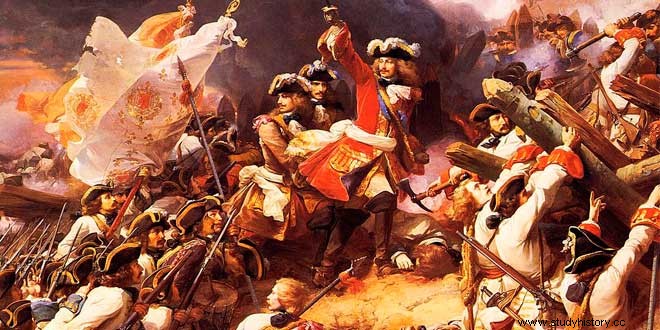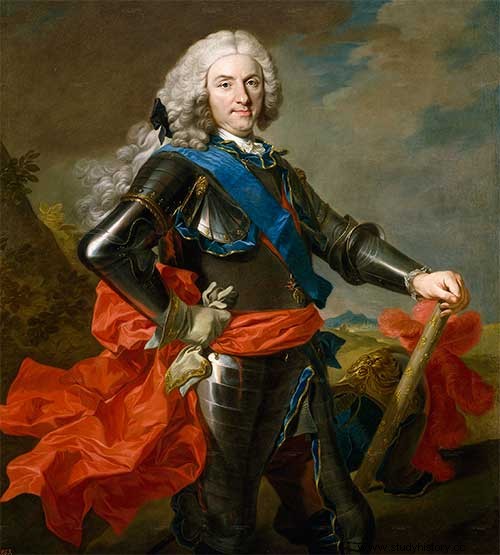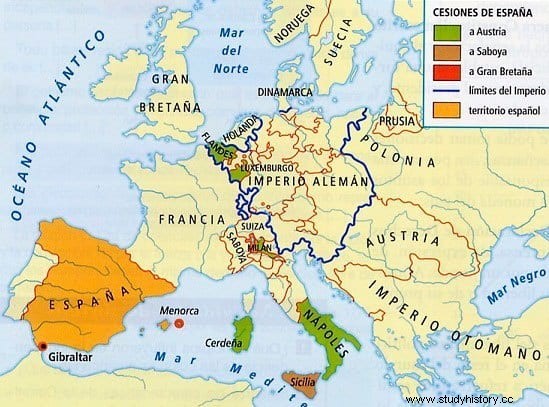Charles II's testament favoring Philip of Anjou as successor to the Spanish throne as Philip V (1700-1746), included a clause that forced him to renounce the French crown, thereby avoiding the union of the two great European nations. However, Louis XIV issued letters patent to the Parliament of Paris (February 1701) in which he named Philip successor to the throne of France, which provoked the angry protests of Leopold I of Austria, Emperor of Germany, who feared the hypothetical threat the rise of a new power. These misgivings were shared by Holland and England, more favorable to a policy of European balance. Louis XIV's response consisted of the occupation of the fortresses on the border of Spanish Flanders, whose defense was entrusted to Dutch troops, in accordance with the Treaty of Ryswick of 1697.
Start of the War of Succession in Spain
The War of Succession in Spain (1701-1714), comes to be considered by historiography as one of the first great European conflicts of the Modern Age, extending from Spain to the North Sea. Austria, England and Holland signed the Great Alliance of The Hague (September 7, 1701), against Louis XIV, to which Portugal and Savoy adhered, in 1703 .
The departure of Philip V to Italy (1702), to quell the Neapolitan revolt, would allow the Austrian faction to organize a conspiracy in which the Count of Melgar was supposedly involved. The return of King Felipe to Spain coincides with court intrigues around Queen María Luisa, who had remained as regent. The result of the same concluded with the departure from the court of the hitherto influential Portocarrero and Arias, as well as the strengthening of the influence of Louis XIV on Spanish politics.
The aspirations of the Habsburgs to regain the Spanish throne led to the proclamation of Leopold I's second son, Archduke Charles of Austria, as King of Spain, who received the rights to the throne from his father with the connivance of the allied powers in Vienna. (September 12, 1703). To obtain support in Spanish territory, the Austrians approached the Portuguese court of Pedro II, which recognized the archduke as legitimate successor, taking the title of Carlos III (May 7, 1704), and publishing a manifesto against the rights of Felipe to the throne of Spain.
The course of the war on the Peninsula began with the campaigns in Portugal (1704-1705), where Austrian and Bourbon forces clashed . The offensive of the supporters of Archduke Carlos managed to take positions in Andalusia, Levante, Catalonia and Naples. Gibraltar falls into English hands on August 4, 1704. Support for the Austrian cause had spread in the territories of the former Crown of Aragon due to the activity of the Count of Cifuentes. After failing in Cádiz, they obtained support in Denia, where Carlos was proclaimed king of Spain (August 8, 1705), and from there an advance began that culminated in the capture of Valencia (December 16).

Reign of Felipe V
During the first years of his government, Felipe V undertook a political-administrative reform in Spain, with the creation of a system of Provincial Courts and Intendances that populated the Spanish map. In principle, two Departments were created (similar to the current ministries), which from 1714 would be expanded to four:State, War and Navy, Grace and Justice and Indies.
Felipe V, who had surrounded the city of Barcelona with his troops (1706), before the advance of the allies and a foreseeable attack on Madrid, decided to abandon the siege and go to the Court. After reaping a series of victories in Plasencia, Navalmoral, Almaraz and Ciudad Rodrigo, the Court and the Felipista councils left for Guadalajara. A part of the high nobility (counts of Gálvez, Oropesa, Haro and Lemos) recognized Carlos III as king. The Austrian troops entered Madrid (June 25, 1706), and forced the corregidor Marquis de Fuente-Pelayo and the city council to swear allegiance to Carlos III. Some Castilian cities, such as Segovia, Toledo, and Alcalá, among others, received the Carlist armies without enthusiasm, while the Court of Philip V moved to Burgos.
Advance of Philip V's troops
Military support came to the aid of Felipe V, who began to recover positions and with the help of the population was once again acclaimed as king in Madrid (August 4, 1706) . The Court would still see the proclamation of the Archduke Carlos as king, with the name of Carlos III, during the two months that he occupied the capital in 1710. The victory of Felipe V in the battle of Almansa (April 25, 1707), opened the Felipista troops -led by Felipe de Orleans and the Duke of Berwick- the gates of Valencia (May 8). Later, while the Duke of Orleans reached Aragon and seized Zaragoza, French troops commanded by Noailles entered the Empordà. The victory of Almansa was also considered a good opportunity to eliminate regional particularisms and print a series of reforms aimed at uniformity in the kingdoms:the result was the pragmatics of the Nueva Planta (June 29, 1707), which in practice it meant the disappearance of different Aragonese and Valencian institutions (Aragon Justice, Aragonese and Valencian jurisdictions, abolition of the Council of Aragon) and the adaptation to the laws and government of Castile (city councils governed by aldermen, introduction of the equivalent, Castilian laws applied in Aragon and Valencia…).
The decisive Bourbon battles of Brihuega (December 9, 1710) and Villaviciosa (December 10, 1710) did not allow, for the time being, to conclude the final offensive on Catalonia.

Lossofinternationalsupport
The international situation was increasingly prone to negotiations for peace in the peninsular war. Archduke Charles left Barcelona (1711) to be crowned emperor in Frankfurt with the title of Charles VI (December 1711) . The Catalans, without external support, but encouraged by the Generalitat, resisted the felipista push, in defense of their privileges, until the capture of Barcelona (September 13, 1714). A Government Board was appointed for the city, chaired by José Patiño. In 1716, the New Plant Decree was issued for Catalonia, which equated its administration with that of Castile, as had happened years before in the kingdoms of Aragon and Valencia.
While in Spain the supporters of the Bourbons were gaining ground, on the European fronts of the Netherlands and Italy, Louis XIV was losing ground. To the defeats on the battlefield were added the agricultural and demographic crisis, which lasted from 1708 to 1710, especially weakening the Spanish and French economy and population. Due to the crisis, military operations in the Iberian Peninsula were limited in 1709, as French troops and generals returned to their country, under pressure from the allies.
End of the War of Succession
The end of the War of Succession had its correlate in the signing of the Treaties of Utrecht and Rastadt .
In Utrecht (1713), various agreements were made to put an end to the armed conflict . In March, the United Kingdom, Prussia and Savoy signed peace with France. Spain and the United Kingdom ratified the concord (July 10, 1713) and, shortly after, Spain signed peace with Savoy (August 13). The consequences of both had different content clauses:political (Philip V's recognition of the succession of Spain, with the condition of formally renouncing all his rights to the Crown of France), territorial (Spanish transfer of different domains to the United Kingdom, to the Emperor and Savoy) and commercial (English commercial monopoly in Spanish America, through the so-called ship of permission ). Despite these treaties, the war would continue during 1712 and the spring of 1713, on the Portuguese, Flemish and Catalan borders, with indecisive results.
In Rastadt or Rastatt (1714), in addition to recognizing the Treaty of Utrecht, various agreements were signed between Spain, the United Kingdom and Austria so that the foreign troops established in Catalonia would leave the territory, in exchange for an amnesty promised by Philip V to the Catalans, which did not include the preservation of their own privileges. With Holland, the Peace of El Pardo was signed (June 26, 1714) and a new agreement was reached with Portugal (February 6, 1715).
SituationofEuropeaftertheWarofSuccession
Spanish revisionism put to the test the Treaties of Utrecht and Rastadt (considered “British-inspired letters”) that brought Europe a provisional and necessary Peace, given the exhaustion of the belligerents. However, after the death of Louis XIV (September 1, 1715), a confused and intriguing diplomatic period began. Both Felipe V and Carlos VI of Austria were designing two policies in the Mediterranean, in which both saw Italy and its domination as a priority objective. From then on, Spanish policy in Italy would owe much to the ability and attitude of an Italian cardinal, Philip V's main adviser:Giulio Alberoni.

